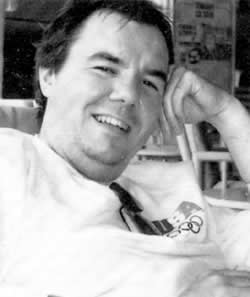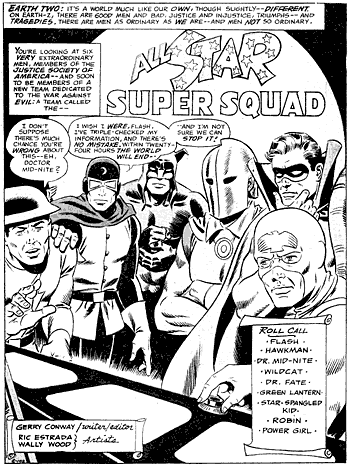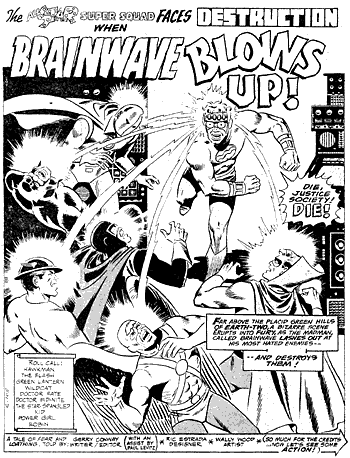All The Stars There Are in (Super-hero) Heaven!
The 1970s Justice Society Revival-All-Starring the Original Cast!
by Roy Thomas
GERRY CONWAY
(Writer/editor, All-Star Comics #58-62)
From Alter
Ego Vol. 3 #14
In Alter Ego #14, you'll find Roy's take on the 1970s JSA revival. You can
find mini-interviews with some of the other participants: Paul
Levitz, Gerry Conway, Ric
Estrada, Keith Giffen, Al
Milgrom & Joe Staton.

Gerry Conway in the 1970s.
GERRY CONWAY: My recollection of events from the mid-'70s is a bit vague,
at least when it comes to the details of why I did things a certain way in a
certain issue. At the time I was writing and editing half a dozen magazines
a month, with a part-time assistant, in an editorial regime that, in many ways,
was the bureaucratic opposite of the system in place at Marvel, where I'd been
for the previous five years. In contrast, today's comic book editors handle
about four titles a month, under the direction of "group editors"
and with a full-time assistant. My position at DC was somewhat difficult and
unique: I was trying to do comics the way I'd done them at Marvel, and that
put me up against a pretty entrenched creative structure.
It was a hectic, exciting, frustrating, and rewarding time-and I was only 23
years old! I couldn't have accomplished anything at all (to the degree that
I did) without the support and encouragement of Carmine Infantino, Paul Levitz,
and Joe Orlando... not to mention your very helpful kibitzing.
ROY THOMAS: Which of course was very much off the record, since at the
time I was under contract to Marvel! Do you recall, one night in 1975, our talking
over possible new projects you might initiate at DC, and my suggesting the revival
of All-Star and a full-blown Superman-Captain Marvel fight? Not that I want
to claim any credit for what you did with the concepts... I'm just curious.
CONWAY: I don't recall the specific conversation, but I know we talked
about it. Your interest in an All-Star revival certainly put me on the path
to championing it at DC. Obviously, because of my age at the time, I was only
familiar with the "Earth-Two" version of the JSA, as per the annual
JLA-JSA team-ups, so I think it was your enthusiasm for the team's potential
that inspired me, more than anything else.
RT: Later you offered me a chance to ghost-write an issue or so of All-Star.
But I preferred not to, since it would have had to be anonymous... and I wanted
any JSA story I wrote to have my name on it. How did Ric Estrada and Wally become
the art team?
CONWAY: I didn't have access to the so-called "good" artists-and
I'm not sure I would have agreed with that designation at DC then anyway! Most
of the artists I worked with then were people the other editors wouldn't use,
because they were either brand new (Keith Giffen) or were perceived as being
"burned out" (Steve Ditko, Wally Wood) or just not "good enough"
for the traditional DC super-hero book (Ric Estrada, Ernie Chan, Dick Ayers,
Chic Stone). But I'd seen Ric's pencils on some books Joe Orlando was doing
(I think), and thought he had a great storytelling/design sense.
Wally Wood, of course, was a master of long standing-though his stock had fallen
somewhat among other editors at that time-but I'd never felt his storytelling
was his strong suit. I had this (probably crackpot) theory that one could combine
artists with different strengths and that the whole would be greater than the
parts. I thought the teaming of Ric's pencils and Wally's inks would be exciting,
and I was right (I'd like to think).
RT: Was Paul Levitz your assistant editor from the beginning?
CONWAY: If not from the beginning, very soon afterward. I believe I also
worked with Alan Asherman. An anecdote: shortly after I started working at DC
as an editor, the powers-that-be decided to eliminate all assistant editors
to cut costs. Joe Orlando and I split Paul's salary out of our own pockets to
keep him on. Which raises the question: If we hadn't done that-would Paul be
co-running DC Comics today?
RT: Joe Orlando is usually given credit for designing Power Girl, but
Amazing World of DC Comics back in '75 printed what might be a design sketch
by Ric. If Joe designed Power Girl, then why the Estrada sketch?
CONWAY: In the '70s, when I was writing comics at DC and Marvel, I made
it a practice to sketch my own ideas for the costumes of new characters-heroes
and villains-which I offered to the artists as a crude suggestion representing
the image I had in mind. I had done that with The Punisher at Marvel. Similarly,
I sketched a crude version of Power Girl, including the open circle on her chest,
which either Joe or Ric developed into the finished design.
RT: So there may have been as many as three design sketches for Power
Girl, starting with yours! According to a Levitz letters page, Wally Wood suggested
closing up the bare spot on Power Girl's chest. Hardly a major point, but...
CONWAY: Actually, closing the circle on Power Girl's costume was [publisher]
Jenette Kahn's idea. She felt it was sexist, and she was probably right. I doubt
Wally would have had such qualms, given his taste for ill-clad buxom babes.
(A taste I share, by the way, and another reason why this former Catholic boy
will probably burn in hell.)
RT: Did you consciously decide to re-design Brain Wave (in #58), then
Degaton (in #59)? Degaton became a scientific genius, too, which he hadn't been
in the '40s.
CONWAY: The original versions of those characters seemed pretty musty
to me at the time. I was doing a contemporary, "modern" version of
the JSA, with younger characters, in a very different style from that of the
original series. I'm probably a bit of a philistine, but I never felt much commitment
to consistency for its own sake-sigh.


The first two splashes for the revived All-Star, by Estrada and Wood. Boy, had
The Brain Wave changed since his last previous appearance, in 1947's All-Star
#37. [©2002 DC Comics.]
RT: How was the choice made to include Power Girl, Robin, and Star-Spangled
Kid in the JSA-and how did the "Super-Squad" idea emerge?
CONWAY: As I said, I wanted to do a "modern" group-which at
the time meant kids in costume. Youth rules-and the original JSA characters
were a bit long in the tooth, according to continuity (even given that time
seemed to run at a different rate on Earth-Two). Robin was a nod to the present;
The Star-Spangled Kid was a nod to the past; and Power Girl was an attempt at
something "new."
Calling the resulting group the "Super-Squad" was intended to differentiate
it from the JSA. Also, while I wanted to use the All-Star name for the comic,
I knew that, in fact, none of these characters were what readers of the '70s
would consider to be "stars." Hence, "Super-Squad." Which
also avoided the acronymic problem presented by the alternative "All-Star
Squad."
RT: You mentioned Star-Spangled Kid as being from the 1950s, but of
course it was actually the '40s. And did you give him Starman's rod because
he lacked power otherwise?
CONWAY: I guess when I was writing that particular bit I confused Star-Spangled
Kid and Stripesy with Captain America and Bucky (for obvious reasons)! Since
Cap and Bucky's careers continued into the '50s despite Stan's assertion in
Avengers #4 to the contrary (and let's not get started on the continuity problems
that created!), I must've assumed the same was true with SSK. Sloppy continuity
on my part, but I suppose I'm in good company. As for Starman's rod, you're
right-I gave it to the Kid in order to increase his power potential profile.
RT: Did you write most or all of your All-Star scripts in advance, or
"Marvel style"?
CONWAY: Marvel style.
RT: I got a kick out of your inviting Jerry Bails and me to write letters
to appear in your very first issue.
CONWAY: Had to do it, didn't I?
RT: You had several high-profile projects at this time, including the
Superman/Spider-Man team-up. Were these pretty heady days, with that, All-Star,
and soon Return of the New Gods?
CONWAY: Absolutely. Heady, and a bit depressing, given the circumstances
that had brought me to DC. Nonetheless, I had a lot of fun, and I was given
more independence than I probably deserved, thanks to Carmine.
RT: Was it you who decided to have Wildcat talk less intelligently for
contrast, or was that inherited from somewhere?
CONWAY: I don't recall. Probably another continuity seizure on my part.
RT: Why did Ric Estrada leave after #59... and how did newcomer Keith
Giffen get the job?
CONWAY: I don't recall why Ric left. I gave Keith the assignment based
on his samples. Like Ric, he had a very strong design/storytelling sense, though
his draftsmanship wasn't as polished as it later became. Nobody would use him,
but I thought he'd do a kick-ass job, and I'd like to think I was right. I later
brought him over to Marvel, where he penciled The Defenders for me, I believe.
RT: The villain Vulcan, Son of Fire, in #60-61, was a good one. Any
roots we should know about, besides maybe Thor crossed with a mad astronaut?
CONWAY: Wasn't Vulcan, Son of Fire, a Charlton character written by a
certain Missouri boy before it was shamelessly stolen by some hack at DC-or
am I getting that confused with something else? Probably. [ED. NOTE: Gerry refers
to Son of Vulcan, the mid-'60s Charlton comic which was Roy T.'s first professional
writing job.]
RT: Paul Levitz wound up dialoguing #62, with Zanadu the Lemurian-your
last issue. That's the point at which you quit to go back to Marvel. Were any
concepts of yours-bringing in The Shining Knight, a third Injustice Gang, etc.-left
behind for Paul to use?
CONWAY: We probably talked about it, but whatever followed my departure
is to Paul's credit.
RT: Did you have any regrets about leaving All-Star and your other new
projects to return to Marvel in early '76?
CONWAY: Well, considering that I stayed at Marvel only a year that time,
yes. DC was going through a major creative upheaval in the mid-'70s, an exciting
time.
RT: During that DC sojourn you also did the first real Superman/Wonder
Woman co-starrer, but set in World War II and thus on Earth-Two. Any reason?
It was a very good book, with Garcia-Lopez art.
CONWAY: Like yourself, I'm a bit of a history buff (real history, not
comics history, though). I thought it would be fun to do a story set in World
War II. In any case, I've long felt that some characters work best in certain
historical contexts and not in others. Wonder Woman always struck me as a character
who belonged in the 1940s.
RT: And a bit later you created Steel, the Indestructible Man, also
set during World War II.
CONWAY: Steel was intended to be a tip of the hat to the original Captain
America. My favorite Cap stories, when I was growing up, were the ones Stan
and Jack set in World War II, so I was just trying to recapture that feeling.
RT: When you returned to DC a year later, you inherited a Wonder Woman
series set in World War II, because of the first season of her TV series. By
WW #239 you'd returned to a former policy of guest-starring other JSAers. Was
that your idea?
CONWAY: I don't recall. Most of the work I did that first year or so
after my return was as a hired gun, executing my editors' ideas.
RT: Any parting thoughts concerning your 1970s revival of All-Star Comics?
Anything you wish you'd done differently-or anything you're especially proud
of, in retrospect?
CONWAY: I'm proud that we did it. I'm proud of creating Power Girl, who
was certainly one of the first tough babes at DC in the '70s. I'm proud I got
to work with a great artist like Wally Wood, and that I gave Keith Giffen his
first series. I'm proud that I (and Joe Orlando) kept Paul Levitz at DC. If
I had it to do over, at the same age and with the same skill set I had then,
I doubt I would have done anything differently.

Sign up here to receive periodic updates about what's going on in
the world of TwoMorrows Publishing.

Click here to download
our new Fall-Winter catalog (2mb PDF file)
Howard Keltner's Golden Age Comic Books Index is the premier
references for Golden Age comics! Bob Klein worked with Howard
to make this edition available, just before Howard's untimely death
in 1998. Howard's widow has graciously given us permission to give
the index away for free for all to enjoy! Click
here to view! (1.5 MB file. Adobe
Reader required.) |